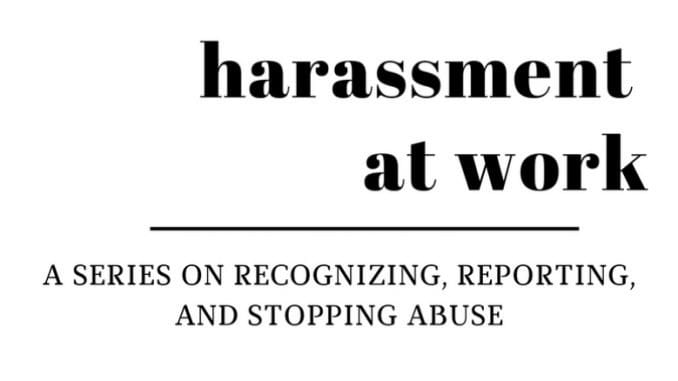
Harassment at work is real, but what do you do when it happens to you? How do you know when someone’s behavior has crossed the line? And who do you tell? In this eight-part series, we break down what harassment is and what to do about it.
BY ASHLEY RODRIGUEZ
BARISTA MAGAZINE ONLINE
Note: This series will explore issues of harassment and recount episodes of alleged harassment in the workplace. If you are sensitive to stories and scenarios depicting workplace harassment, please be advised.
This series is an accompaniment to the February + March 2018 article, “Coexisting at Work: Sexual Harassment Policies,” written by Lauren Lathrop. It’s meant to define sexual harassment and provide a blueprint as to how to handle workplace harassment. The first part of this series defined harassment, part two talked about legal protections and laws defining sexual harassment, part three discussed the various forms of documenting harassment, and part four talked about evidence. In part five, we’ll discuss the role of bystanders and how they can be the missing link to preventing harassment at work.
In a very, very informal poll taken before writing this series, I asked my friends and some coffee leaders what they have in the way of harassment training at their café. Do they have language in their employee handbook about harassment? Do they undergo regular trainings? I was shocked that many people said they didn’t have rules against harassment because they wouldn’t hire anyone who would harass others.
These responses reminded me of an interview I did with Elle Jensen of Amethyst Coffee in Denver for a print article in the October + November 2017 issue of Barista Magazine. One of the things she mentioned was that “harassment is going to happen,” and it was up to her to make sure her employees felt empowered to do something when they saw it happening. What Elle hinted at—and what studies have shown to be more effective than any sort of harassment training—is that we have to empower our employees to be active bystanders in the face of harassment.
The reason most harassment training fails goes back to one of the tenets of a viable sexual harassment claim: For harassment to exist, an employer had to know, and willfully ignore, harmful actions. This translates into legal jargon thrown into an employee handbook or a one-off training meant to demonstrate that a company isn’t liable for the actions of its employees instead of stopping harassment. Likewise, harassment training often misses its intended audience—those likely to commit harassment aren’t likely to identify their behaviors or actions in the trainings they sit in on or in the handbooks they might never read. Research also suggests that traditional sexual harassment trainings reinforce gender stereotypes, and paint one group as the predators and the other as the victims.
What has worked, and has been used in places like college campuses and the military, is bystander training, which aims to empower all people to stop sexual harassment. The narrative isn’t about what to do when you’re harassed, but what to do when you see harassment happen.
I went to one of these training recently, called the Green Dot Bystander Intervention Program. This program was developed by Dr. Dorothy Edwards, and it is meant to give students the tools to safely intervene in a situation where someone may potentially be harassed. In this training, they focused on three principles:
DIRECT: Direct intervention is pretty straightforward—when you see something that makes you uncomfortable or you fear for the safety of another, you get directly in the middle if you feel safe enough to do so. This doesn’t have to always be a direct confrontation (although it can be), but generally involves putting distance between the aggressor and the victim in some form. An example of direct intervention might be a bartender who checks in on a patron who they notice might be getting unwanted attention from another person, and it’s as simple as asking, “Hey, are you OK?”
DISTRACT: This strategy involves using a distraction to diffuse a potentially harmful situation. For example, if you notice a couple fighting on the street, asking for directions can be a way to diffuse the situation. In the café, you can talk to an aggressor about a new offering on your menu if you notice tension between people coming up to the register, or you can interrupt a fight between two coworkers with a personal anecdote.
DELEGATE: If you don’t feel comfortable or safe intervening in a situation, or you’re occupied in a way that makes it impossible for you to intervene (like you’re slammed or unable to get to a particular area in the café), you can always ask someone else to intervene. A manager or a senior colleague should be able to step in if you’re unable to; the idea is that just because you don’t think you can stop a situation doesn’t mean you should give up. Get someone else involved if you think a situation is escalating.
These three strategies focus on reactive forms of bystander intervention, but the Green Dot strategy also focuses on proactive forms, or demonstrating through your messaging, word choices, and general vibe and tone of the space that this is a place that does not tolerate harassment. Essentially, the Green Dot strategy focuses on creating safe spaces—green dots on a map. Any time a harmful situation happens, that’s a red dot, but if we can create proactive green dots in the spaces we inhabit, there will naturally be fewer and fewer spaces where people can commit red dot incidents.
Proactive intervention encompasses any messaging you use to communicate that harassment will not be tolerated. Maybe this means having a sign on the bathrooms indicating that they are gender neutral, or using your social media to promote organizations that represent marginalized groups. As individuals, you can also make yourself a “green dot” by sharing a link about bystander intervention or talking about a training you attended with your friends. Regardless, the point of Green Dot training, and trainings in general meant to empower folks to intervene, is to overcome the barriers that might keep people from speaking up. Even if you’re shy, or you’re unsure about the relationship between the people you see fighting, or if you think your coworker might be mad for stepping in, a simple check-in is worth the effort.
You can check out more about Green Dot Intervention Strategies here, and a simple search of bystander trainings yields a plethora of information and resources for folks concerned about harassment.
What else do you want to hear about? In the next few weeks, we’ll be reaching out to HR experts, lawyers, and academics versed in issues of harassment, and we want to know what questions you want answered!
Disclaimer: This article is meant to be informative and provide guidance. This is not meant to be legal advice. This publication is read by a variety of people all over the world, and laws regarding workplace harassment can vary wildly. If you are thinking about filing a workplace harassment lawsuit, please consult a licensed attorney in your state or jurisdiction.

